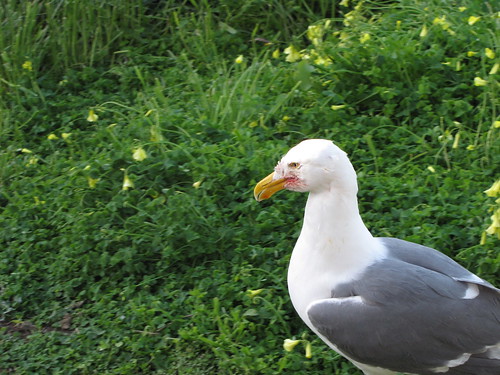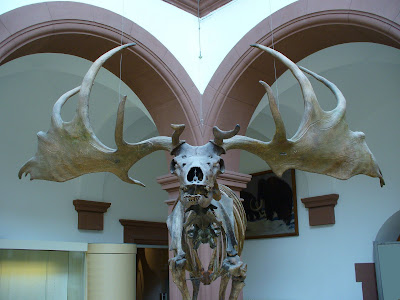Saturday, May 1, 2010
 Gull fights revisited
Gull fights revisited
12:50 PM | Posted by
Sweep Commander |
Edit Post
Let's get nerdy for a minute.
A while back we managed to record a 27 minute gull fight, which by one visitor's testimony, began with an argument over a morsel of chicken.
Whenever I witness such a pointless exercise, I wonder how the larger taxa of gulls could possibly have achieved unfathomable numbers and worldwide distribution when they are prone to costly fights with trivial causes. Why hasn't natural selection blessed them with calm breeding colonies where gulls treat each other with trust and deference, looking after one another, only turning their wrath on malicious intruders?
Evolutionary biologists sometimes refer to a very beneficial adaptation of form or behavior as a "neat trick".
My first thought was that the gull's basket of tricks is so collectively neat that the group can afford to loose a little blood at the margins, especially as the camber of a gull's wing was once described by Stephen Jay Gould as the nearest nature comes to perfection. Also, these guys eat trash, and we make tons of trash. That's the neatest of tricks.
But this explanation of gull on gull violence doesn't seem to work, at least at first. A species may tend to acquire traits that are maladaptive in one regard, e.g. cormorants becoming heavier and so losing their ability to fly proficiently, but it only adds up if in so doing they are improving themselves in another regard, e.g. cormorants becoming heavier and thus more proficient divers. The flightless cormorant has made an outright exchange of its flight capabilities for a body that is singularly adapted to life in the water.
You might think that a gull could hold onto all of its neat tricks of wing design, omnivorous diet and trash consuming opportunism while still being more socially amicable. But this hasn't materialized. What is going on?
The difference between the fitness of an individual and the fitness of a species may provide us with half of an explanation. If all gulls were friendly to their fellow colonists, this would undoubtedly be good for gulls collectively, but it wouldn't benefit individuals who have something to gain from harming their conspecific neighbors. After all, these are creatures who occasionally meet their dietary needs by killing and eating the young of their own species.
The Irish elk is familiar with the difference between collective and individual fitness, or at least it was before it fell into extinction around eight thousand years ago.
Success in the fight for mates is believed to have been partially determined by the size of an individual's antlers. As you might imagine, the antlers grew large and unwieldy. The devlopment of traits that were good for the individual were bad for the survival prospects of the species, possibly bringing it to the point of extinction. The narwhal may be undergoing a similar process if sexual selection is causing the size of their otherwise useless tusks to grow over generations.
Perhaps the popularity of these violent traits among gulls can be partially explained by understanding how they benefit the individual gull who displays them rather than all gulls at large. I'd imagine that arriving at a gull colony like Alcatraz is a little like arriving at a functioning prison in that the sage advice is to find a suitable target and pick a fight over something trivial. Win or lose, it will be known that you will defend yourself, your territorial boundaries, your hard won food, your eggs and your young. It would harm your prospects if other gulls recognized you as a bird which habitually engages in appeasement to avoid violence. My guess is that this is part of the answer.
For additional clues, we should think back to the case of the cormorant taxa and their tendency towards compromising their ability to fly in order to enhance their ability to dive. Although it seems like gulls aren't trading away their ability to socialize by making an analogous bargain, on reflection, I think that they are.
Gulls are vicious predators and they're wildly successful in that regard. They are well served by yet another neat trick that is easily obscured by their superficially unobtrusive and harmless presentation. This trick is their willingness to inflict harm at the drop of a shred of chicken, to aggressively fight over any edible trash, and to attack and kill any sick, injured or otherwise vulnerable animal. LadyBird, BourbonHawk and I saw a gang of gulls butcher and eat the cutest baby geese you'll ever see.
I can't know for sure, but I strongly suspect that the gull's abidingly malevolent orientation towards all other creatures, which serves it well in many respects, is guaranteed by hormones and brain structures that are too rigid to be switched off for interactions with their own kind and on again for perpetrating violence against victims of other species.
As a result, each of our western gulls appears to be out for itself. The bloody tendencies designed to serve its feeding strategies have generalized, giving shape to each bird's interactions with its fellow WEGUs. That, and the possibility that natural selection based upon individual and not collective fitness has given form to gull social behavior, may serve to explain the paradoxical observation of two gulls fighting for 27 minutes over a 40 calories of discarded chicken.
Also, I know this wasn't news, but it's been on my mind lately. News soon to come on goslings, ravens, gulls, snowy egrets, and the world famous Alcatraz peregrine tiercel.
Subscribe to:
Post Comments (Atom)
MEET THE ALCATRASH
Contact Maganrord
maganrord (at) gmail.com
Blog Archive
-
▼
2010
(73)
-
▼
May
(13)
- Alcatraz has babies! Cuteness overload!
- It's here...
- Rehash: Alcatraz is an awful place for geese to breed
- Now, we wait...
- A call to experts: is this the head of a juvenile ...
- Oh, bloody murder
- Mommy, what is "stacking"? Also, babies, babies, b...
- the tales that odd plumage will tell you
- Bird Census: American crow
- Update on our brave young falcon, raven news
- is the last Alcatraz gosling too big to fail?
- Young ravens hatch, parents behave cryptically (an...
- Gull fights revisited
-
▼
May
(13)




0 comments:
Post a Comment
holla back!
Note: Only a member of this blog may post a comment.